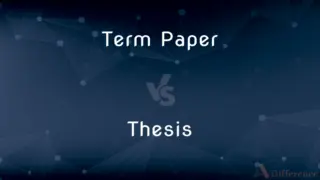Tendon vs. Aponeurosis — What's the Difference?
Edited by Tayyaba Rehman — By Fiza Rafique — Updated on September 30, 2023
A "tendon" is a fibrous tissue connecting muscle to bone. An "aponeurosis" is a broad, flat sheet of connective tissue connecting muscle to muscle or bone. Both play roles in muscle function.

Difference Between Tendon and Aponeurosis
Table of Contents
ADVERTISEMENT
Key Differences
Both "tendon" and "aponeurosis" are specialized structures in the body that play crucial roles in the movement and function of muscles. A "tendon" is a strong, cord-like structure made of fibrous connective tissue. It serves as the attachment between muscles and bones. When muscles contract, tendons enable the force to be transferred to bones, thus facilitating movement. "Aponeurosis", meanwhile, is a broad, flat sheet of similar tissue.
In terms of structure, a "tendon" is more cylindrical or cord-like and is often seen at the ends of muscles. These tendons, being relatively inelastic, provide a stable connection that ensures efficient transmission of muscle power to the skeletal system. On the contrary, "aponeurosis" tends to be wider and flatter, providing a large area of attachment. It can connect muscle to muscle or muscle to bone.
Functionally, while both "tendon" and "aponeurosis" assist in transmitting the force produced by muscle contractions, the broader surface area of an aponeurosis can distribute this force over a larger space. This distribution can be especially useful in areas where force needs to be spread out, like in the abdominal region.
To understand their significance, consider the example of the Achilles tendon, one of the strongest and most prominent tendons, connecting the calf muscles to the heel bone. Without it, walking or running would be impossible. Similarly, the aponeurosis in the back, called the thoracolumbar aponeurosis, provides a large attachment area for several significant back and abdominal muscles.
Comparison Chart
Basic Definition
Cord-like structure connecting muscle to bone.
Broad, flat sheet connecting muscle to muscle/bone.
ADVERTISEMENT
Shape
Cylindrical or cord-like.
Broad and flat.
Elasticity
Relatively inelastic.
Slightly more elastic than tendons.
Function
Transfers muscle force to bones.
Distributes force over a larger area.
Examples
Achilles tendon.
Thoracolumbar aponeurosis.
Compare with Definitions
Tendon
An integral component in joint movement.
A torn tendon can severely limit joint mobility.
Aponeurosis
A flat, wide tendinous expansion.
The aponeurosis provides a large area for muscle attachment.
Tendon
A fibrous cord connecting muscles to bones.
The Achilles tendon is vital for walking and running.
Aponeurosis
Connective tissue linking muscles or bones.
He had an injury to the aponeurosis in his lower back.
Tendon
A structure that transmits forces from muscle to bone.
The tendon's rupture required immediate medical attention.
Aponeurosis
The tendinous sheet providing a foundation for muscle fibers.
The palm's aponeurosis can sometimes thicken, causing contractures.
Tendon
The tough, inelastic end part of a muscle.
She strained her wrist tendon while lifting weights.
Aponeurosis
A broad sheet of fibrous tissue connecting muscles or supporting organs.
The rectus abdominis attaches to the anterior aponeurosis.
Tendon
The tissue through which muscles anchor to bones.
He felt a sharp pain in the tendon behind his knee.
Aponeurosis
A structure assisting in force distribution in muscle regions.
The scalp has an intricate aponeurosis connecting various muscles.
Tendon
A tendon or sinew is a tough high-tensile-strength band of dense fibrous connective tissue that connects muscle to bone and is capable of withstanding tension and transmit the mechanical forces of muscle contraction to the skeletal system. Tendons are similar to ligaments; both are made of collagen.
Aponeurosis
An aponeurosis (; plural: aponeuroses) is a type or a variant of the deep fascia, in the form of a sheet of pearly-white fibrous tissue that attaches sheet-like muscles needing a wide area of attachment. Their primary function is to join muscles and the body parts they act upon, whether it be bone or other muscles.
Tendon
A band of tough, inelastic fibrous tissue that connects a muscle with its bony attachment.
Aponeurosis
A sheetlike fibrous membrane, resembling a flattened tendon, that serves as a fascia to bind muscles together or as a means of connecting muscle to bone.
Tendon
(anatomy) A tough band of flexible but inelastic fibrous collagen tissue that connects a muscle with its bony attachment and transmits the force which the muscle exerts.
Aponeurosis
(anatomy) A flattened pearly white fibrous membrane taking the place of a tendon that binds together and forms the terminations and attachments of muscles or connects them to other body parts like skin or bone.
Tendon
(biology) The hamstring of a quadruped.
Aponeurosis
Any one of the thicker and denser of the deep fasciæ which cover, invest, and the terminations and attachments of, many muscles. They often differ from tendons only in being flat and thin. See Fascia.
Tendon
(construction) A wire or bar used to strengthen prestressed concrete.
Aponeurosis
Any of the deeper and thicker fascia that attach muscles to bones; resemble flattened tendons
Tendon
A tough insensible cord, bundle, or band of fibrous connective tissue uniting a muscle with some other part; a sinew.
Tendon
A cord or band of inelastic tissue connecting a muscle with its bony attachment
Common Curiosities
What happens when a Tendon is torn?
A torn tendon can cause pain, swelling, and limited mobility in the affected area.
What is the primary role of a Tendon?
The primary role of a tendon is to connect muscle to bone, allowing movement.
Where might you find an Aponeurosis in the body?
Aponeuroses are commonly found in areas like the abdomen, palms, and scalp.
How does an Aponeurosis support muscle function?
Aponeurosis distributes force over a wider area, helping in balanced muscle function.
Is Aponeurosis similar to Tendon?
While both are connective tissues, aponeurosis is a flat sheet, whereas tendons are more cord-like.
Can Tendons stretch easily?
Tendons have limited elasticity and do not stretch as easily as muscles.
Why is the Achilles Tendon so significant?
The Achilles tendon, connecting the calf muscles to the heel, plays a pivotal role in walking and running.
Is the Aponeurosis more elastic than a Tendon?
Aponeurosis can be slightly more elastic than tendons due to its sheet-like structure.
Can injuries to Tendons heal on their own?
Minor tendon injuries may heal with rest, but severe tears might require medical intervention.
What might cause inflammation in a Tendon?
Tendonitis, an inflammation of the tendon, can be caused by overuse or acute injuries.
Are tendons present throughout the body?
Yes, tendons are found wherever muscles connect to bones, from fingers to toes.
What's the visual difference between Tendon and Aponeurosis?
Tendons are usually cord-like, while aponeuroses appear as broad, flat sheets.
How does the Aponeurosis of the palm function?
The palm's aponeurosis helps in hand movements and grip strength.
What materials make up a Tendon?
Tendons are primarily made of collagen, a protein providing strength and structure.
Can exercises help strengthen Aponeurosis?
Yes, specific exercises can help maintain the health and strength of aponeuroses.
Share Your Discovery

Previous Comparison
Swamp vs. Bayou
Next Comparison
Filament vs. FiberAuthor Spotlight
Written by
Fiza RafiqueFiza Rafique is a skilled content writer at AskDifference.com, where she meticulously refines and enhances written pieces. Drawing from her vast editorial expertise, Fiza ensures clarity, accuracy, and precision in every article. Passionate about language, she continually seeks to elevate the quality of content for readers worldwide.
Edited by
Tayyaba RehmanTayyaba Rehman is a distinguished writer, currently serving as a primary contributor to askdifference.com. As a researcher in semantics and etymology, Tayyaba's passion for the complexity of languages and their distinctions has found a perfect home on the platform. Tayyaba delves into the intricacies of language, distinguishing between commonly confused words and phrases, thereby providing clarity for readers worldwide.















































